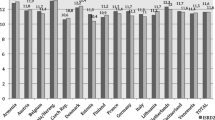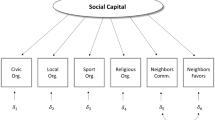Abstract
While the majority of studies on community crime have focused on socio-economic characteristics that lead to high or low rates of crime, the impact of crime on community residents’ social ties has received less attention. This study examines the impact of district-level crime rate, experience of crime, and fear of crime on individual community residents’ participation in association—which has been widely seen as an indicator of social capital—in the city of Seoul, South Korea. Moreover, as recent social capital studies look deeper into the different types of neighborhood crime connected to different types of associations, this study separately examines the impact of total crime, violent crime, and property crime on the respondents’ social, civic engagement, reward-based, and online associations. We find that district-level crime rates negatively correlated with all types of associations, but the difference between violent crime and property crime was minimal. Additionally, individual-level experience of crime significantly decreased residents’ participation in social and online associations. However, fear of crime did not show a significant effect on any type of association.
Similar content being viewed by others
References
Berkowitz, B. 2000. Community and neighborhood organization. In Handbook of community psychology, ed. J. Rappaport, and E. Seidman, 331–357. Berlin: Springer.
Brehm, J., and W. Rahn. 1997. Individual-level evidence for the causes and consequences of social capital. American Journal of Political Science 41 (3): 999–1023.
Buonanno, P., D. Montolio, and P. Vanin. 2009. Does social capital reduce crime? The Journal of Law and Economics 52 (1): 145–170.
Bursik, R.J. 1988. Social disorganization and theories of crime and delinquency: Problems and prospects. Criminology 26 (4): 519–552.
Bursik, R.J., and H.G. Grasmick. 1999. Neighborhoods and Crime. Lanham: Lexington Books.
Choi, J.H. 2006. Living in Cyworld: Contextualizing Cy-Ties in South Korea. In Use of blogs (digital formations), ed. A. Bruns and J. Jacobs, 173–186. New York, NY: Peter Lang.
Cohen, L.E., and M. Felson 1979. Social change and crime rate trends: A routine activity approach. American Sociological Review 44 (4): 588–608.
Cohen, L.E., and R. Machalek. 1994. The normalcy of crime: From Durkheim to evolutionary ecology. Rationality and Society 6 (2): 286–308.
Collins, R. 2004. Rituals of solidarity and security in the wake of terrorist attack. Sociological Theory 22 (1): 53–87.
Conklin, J.E. 1975. The impact of crime. New York: Macmillan.
Curtis, J.E., D.E. Baer, and E.G. Grabb 2001. Nations of joiners: Explaining voluntary association membership in democratic societies. American Sociological Review 66 (6): 783–805.
Delhey, J., and K. Newton. 2003. Who trusts? The origins of social trust in seven societies. European Societies 5 (2): 93–137.
Deller, S.C., and M.A. Deller. 2010. Rural crime and social capital. Growth and Change 41 (2): 221–275.
Deller, S.C., and M.A. Deller. 2012. Spatial heterogeneity, social capital, and rural larceny. Rural Sociology 77: 225–253.
Durkheim, E. 2014. The rules of sociological method: and selected texts on sociology and its method. New York: Simon and Schuster.
Felson, M., and L.E. Cohen. 1980. Human ecology and crime: A routine activity approach. Human Ecology 8 (4): 389–406.
Hindelang, M.J., M.R. Gottfredson, and J. Garofalo. 1978. Victims of personal crime: An empirical foundation for a theory of personal victimization. Cambridge, MA: Ballinger.
Hawdon, J., J. Ryan, and L. Agnich. 2010. Crime as a source of solidarity: a research note testing Durkheim’s assertion. Deviant Behavior 31 (8): 679–703.
Hunter, A.J. 1985. Private, parochial, and public social orders: The problem of crime and incivility in urban communities. In The challenge of social control: Citizenship and institution building in modern society, ed. G.D. Suttles and M.N. Zald, 230–242. Norwood, NJ: Ablex.
Kennedy, B.P., I. Kawachi, D. Prothrow-Stith, K. Lochner, and V. Gupta. 1998. Social capital, income inequality, and firearm violent crime. Social Science and Medicine 47: 7–17.
Kim, J.Y. 2005. “Bowling together” isn’t a cure-all: The relationship between social capital and political trust in South Korea. International Political Science Review 26 (2): 193–213.
Knack, S., and P. Keefer. 1997. Does social capital have an economic payoff? A cross-country investigation. Quarterly Journal of Economics 112: 1251–1288.
Kornhauser, R.R. 1978. Social sources of delinquency: An appraisal of analytic models. Chicago: University of Chicago Press.
Lauderdale, P. 1976. Deviance and moral boundaries. American Sociological Review 41 (4): 660–676.
Lindström, M., J. Merlo, and P. Östergren. 2002. Social capital and sense of insecurity in the neighbourhood: a population-based multilevel analysis in Malmö, Sweden. Social Science and Medicine 56 (5): 1111–1120.
Liska, A.E., and B.D. Warner. 1991. Functions of crime: A paradoxical process. American Journal of Sociology 96 (6): 1441–1463.
Liu, C., and D. Stolle. 2017. Social capital, civic culture and political trust. In Handbook on political trust, ed. S. Zmerli and T.W.G. van der Meer, 338–352. Cheltenham: Edward Elgar Publishing.
Lochner, K., I. Kawachi, and B.P. Kennedy. 1999. Social capital: A guide to its measurement. Health & place 5 (4): 259–270.
Markowitz, F.E., P.E. Bellair, A.E. Liska, and J. Liu. 2001. Extending social disorganization theory: Modeling the relationships between cohesion, disorder, and fear. Criminology 39 (2): 293–319.
Mead, G.H. 1918. The psychology of punitive justice. American Journal of Sociology 23 (5): 577–602.
Messner, S.F., and J.R. Blau. 1987. Routine leisure activities and rates of crime: A macro-level analysis. Social Forces 65: 1035–1052.
Miethe, T.D., M.C. Stafford, and J.S. Long 1987. Social differentiation in criminal victimization: A test of routine activities/lifestyle theories. American Sociological Review 52 (2): 184–194.
Moore, M.D., and N.L. Recker. 2016. Social capital, type of crime, and social control. Crime & Delinquency 62 (6): 728–747.
Moore, M.D., and N.L. Recker. 2017. Social capital groups and crime in urban counties. Deviant behavior 38 (6): 655–667.
Oh, J.H., and S. Kim. 2009. Aging, neighborhood attachment, and fear of crime: Testing reciprocal effects. Journal of Community Psychology 37 (1): 21–40.
Osgood, D.Wayne. 2000. Poisson-Based Regression Analysis of Aggregate Crime Rates. Journal of Quantitative Criminology 16 (1): 21–43.
Palmer, C., A. Ziersch, K. Arthurson, and F. Baum. 2005. “Danger lurks around every corner”: fear of crime and its impact on opportunities for social interaction in stigmatised Australian suburbs. Urban Policy and Research 23 (4): 393–411.
Perkins, D.D., B.B. Brown, and R.B. Taylor. 1996. The ecology of empowerment: Predicting participation in community organizations. Journal of Social Issues 52 (1): 85–110.
Perkins, D.D., J. Hughey, and P.W. Speer. 2002. Community psychology perspectives on social capital theory and community development practice. Community Development 33 (1): 33–52.
Phua, J., and S.A.A. Jin. 2011. ‘Finding a home away from home’: The use of social networking sites by Asia-Pacific students in the United States for bridging and bonding social capital. Asian Journal of Communication 21 (5): 504–519.
Putnam, R.D. 2000. Bowling Alone: The collapse and revival of American community. New York: Simon and Schuster.
Richey, S. 2005. Informal social networking and community involvement: Determining participation in neighborhood crime watches in Japan. Journal of Political Science 33: 143–161.
Robinson, J.B., B.A. Lawton, R.B. Taylor, and D.D. Perkins. 2003. Multilevel longitudinal impacts of incivilities: Fear of crime, expected safety, and block satisfaction. Journal of Quantitative Criminology 19 (3): 237–274.
Rose, D.R., and T.R. Clear. 1998. Incarceration, social capital, and crime: Implications for social disorganization theory. Criminology 36 (3): 441–480.
Rosenfeld, R. 1994. Neighborhoods and crime: The dimensions of effective community control by Robert J. Bursik, Jr., and Harold G. Grasmick. American Journal of Sociology 99: 1387.
Ross, C.E., and S.J. Jang. 2000. Neighborhood disorder, fear, and mistrust: The buffering role of social ties with neighbors. American Journal of Community Psychology 28 (4): 401–420.
Rupasingha, A., S.J. Goetz, and D. Freshwater. 2006. The production of social capital in US counties. The journal of socio-economics 35 (1): 83–101.
Sampson, R.J. 2001. Crime and public safety: Insights from community-level perspectives on social capital. In Social capital and poor communities, ed. S. Saegert, J. Thompson, and M. Warrent, 89–114. Russel Sage Foundation.
Sampson, R.J., and W.B. Groves. 1989. Community structure and crime: Testing social-disorganization theory. American Journal of Sociology 94 (4): 774–802.
Sampson, R.J., and S.W. Raudenbush. 1999. Systematic social observation of public spaces: A new look at disorder in urban neighborhoods. American Journal of Sociology 105 (3): 603–651.
Sampson, R.J., S.W. Raudenbush, and F. Earls. 1997. Neighborhoods and violent crime: A multilevel study of collective efficacy. Science 277 (5328): 918–924.
Saegert, S., and G. Winkel. 2004. Crime, social capital, and community participation. American Journal of Community Psychology 34 (3–4): 219–233.
Shaw, C.R., and H.D. McKay. 1942. Juvenile delinquency and urban areas. Chicago, IL: University of Chicago Press.
Skogan, W.G. 1990. Disorder and decline: Crime and the spiral of decay in American neighborhoods. Berkeley: University of California Press.
Skogan, W.G., and M.G. Maxfield. 1981. Coping with crime: Individual and neighborhood reactions. Beverly Hills, CA: Sage Publications.
Stolle, D., and T. R. Rochon. 1999. The myth of American exceptionalism. In Social capital and European Democracy, ed. Jan van Deth, Marco Maraffi, Ken Newton, and Paul Whiteley, 192–209. London: Routledge.
Takagi, D., K.I. Ikeda, and I. Kawachi. 2012. Neighborhood social capital and crime victimization: Comparison of spatial regression analysis and hierarchical regression analysis. Social Science and Medicine 75 (10): 1895–1902.
Takagi, D., K.I. Ikeda, T. Kobayashi, M. Harihara, and I. Kawachi. 2016. The impact of crime on social ties and civic participation. Journal of Community & Applied Social Psychology. 26 (2): 164–178.
Taylor, R.B. 1996. Neighborhood responses to disorder and local attachments: The systemic model of attachment, social disorganization, and neighborhood use value. In Sociological forum, vol. 11, No. 1, 41–74.
Wandersman, A., and P. Florin. 2000. Citizen participation. In Handbook of community psychology, ed. J. Pappaport and E. Seidman, 247–272. New York: Plenum.
Wilson, J.Q., and G.L. Kelling. 1982. The Police and Neighborhood Safety: Broken Windows. The Atlantic Monthly 127 (2): 29–38.
Author information
Authors and Affiliations
Corresponding author
Rights and permissions
About this article
Cite this article
Lee, J., Cho, S. The impact of crime rate, experience of crime, and fear of crime on residents’ participation in association: studying 25 districts in the City of Seoul, South Korea. Crime Prev Community Saf 20, 189–207 (2018). https://doi.org/10.1057/s41300-018-0047-6
Published:
Issue Date:
DOI: https://doi.org/10.1057/s41300-018-0047-6




